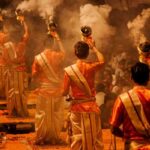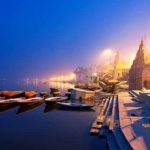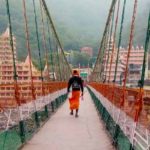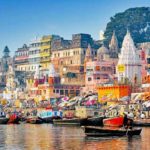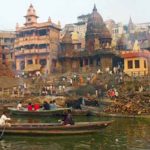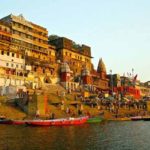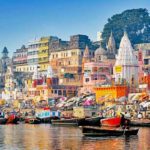Ganga Aarti Varanasi is a spectacle to watch. It is a perfect example of the ancient tradition of River worship in India packaged in a way that it attracts all kinds of people. Pilgrims come to pray at holy Ganga. Tourists come to see the visual where the fire comes to worship the water that sustains life.
The moment you say Ganga Aarti Varanasi, the visuals of Moon shaped Ghats of Ganga cross your mind. The steep steps connecting the Ganga with the city are also the venue for much-captured sights and sounds of the Ganga Aarti.
Every evening, devotees stand before the Ganga, who is lovingly called Ganga Maiyya or mother Ganga. They pray to Ganga with Ganga Aarti and thank her for nurturing them on her banks and for cleansing them with her purifying waters. A lot of devotees, pilgrims, tourists, and travelers gather to watch the spectacle of Ganga Aarti at the famous Dashashwamedh Ghat in Ganga Aarti Varanasi.
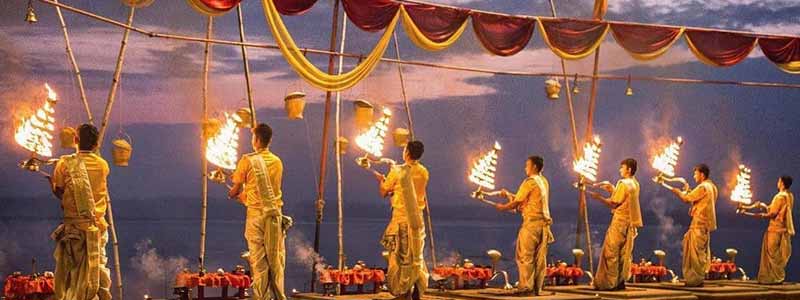
What is a Ganga Aarti?
India’s holy River Ganges, locally known as the Ganga, plays a central role in the life of Hindus. An aarti is a fire ritual, performed to show gratitude to the river and ask for its blessings. It involves the chanting, bells, fire, flowers, and more.
Every evening around sunset, hundreds of people gather at Dasaswamedh Ghat to witness the Ganga Aarti Varanasi. The aarti is performed on a stage by seven young priests. Each is dressed in saffron coloured clothes; a kurta and a dhoti, which is tightly bound with a long towel.
The ceremony begins with the blowing of a conch shell and ringing bells. The priests each wave an incense stick and hold up large flaming lamps while chanting mantras to the goddess Ganga. Their movements are synchronised and the crowd listens in silence while they perform the ceremonial acts.
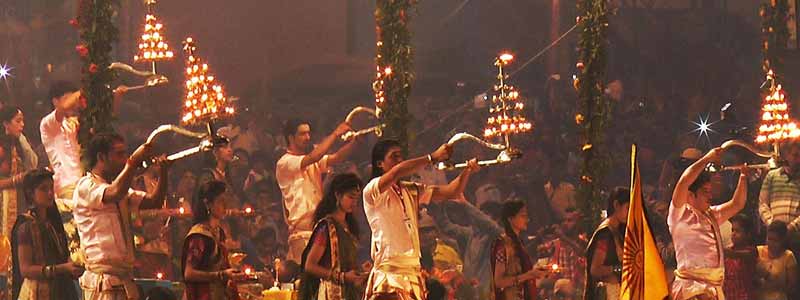
What is a Ganga Aarti?
India’s holy River Ganges, locally known as the Ganga, plays a central role in the life of Hindus. An aarti is a fire ritual, performed to show gratitude to the river and ask for its blessings. It involves the chanting, bells, fire, flowers, and more.
Every evening around sunset, hundreds of people gather at Dasaswamedh Ghat to witness the Ganga Aarti Varanasi. The aarti is performed on a stage by seven young priests. Each is dressed in saffron coloured clothes; a kurta and a dhoti, which is tightly bound with a long towel.
The ceremony begins with the blowing of a conch shell and ringing bells. The priests each wave an incense stick and hold up large flaming lamps while chanting mantras to the goddess Ganga. Their movements are synchronised and the crowd listens in silence while they perform the ceremonial acts.

Ganga Aarti timings
Ganga Aarti begins at 6.45 in the evening and it lasts about 45 minutes.
If you want a good seat – or any seat – you have to be there well in advance. The first time I saw the aarti was from the river in a rowboat. We left early, but unfortunately we didn’t get close enough, so we could barely see anything. There are lots of boats and everyone wants front row.
The second time around we saw it from the banks. We got there at 5pm, which is a tad early, but we got the front seats and it was definitely worth the wait.
Morning Ganga Aarti: A Spiritual Treat for the Soul
The morning aarti is called Subah-E-Banaras and it is considered to be the ideal way to begin a morning in Varanasi. This was an initiative by the State Government of Uttar Pradesh that began in 2014.
It begins with Vedic verses and is followed by the Ganga aarti. A tribute is also paid during the aarti to the four basic elements that comprise everything in this universe: earth, water, sky, and fire, Ganga Aarti Varanasi.
The aarti is the same as the one performed in the evening at Dashashwamedh Ghat, except you can see it more clearly and from a much closer distance because of the fewer people. After the aarti, classical musicians from Banaras Gharana step out with classic music and ragas. Gharanas are important social organisations in northern India. Each organisation specialises in a craft of music or dance. Banaras Gharana was established by Pandit Ram Sahai 200 years ago. It is now one of the six common styles of playing the tabla. Pandit Ram Sahai himself was trained at Lucknow Gharana.
Highlight of the Varanasi aarti
Ganga Aarti in Varanasi is one of the most fascinating ceremonies I’ve ever attended and I recommend not to miss it – even if you’re not religious. Here are some of the highlights of attending an aarti:
- Witnessing the Aarti ritual at the Ganges river
- Walk through the ghats
- River glowing with floating lamps
- Enjoy evening boat ride around Manikarnika Ghat
- Watch the sunset over the River Ganges (if you arrive early)

